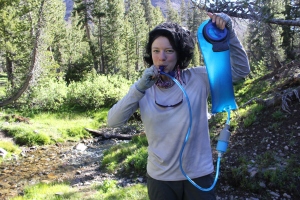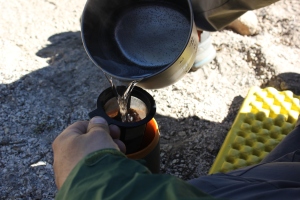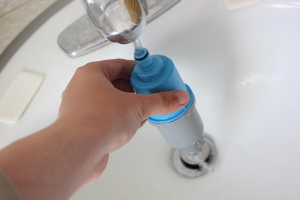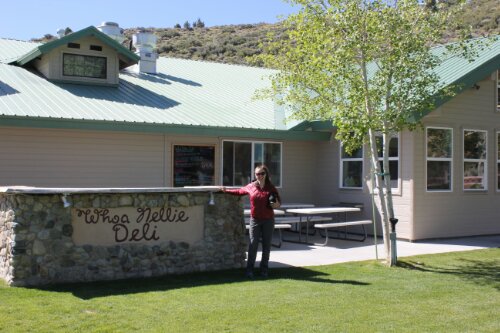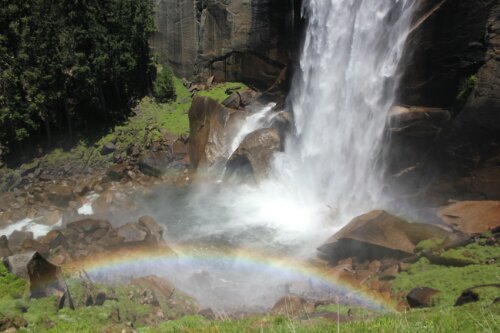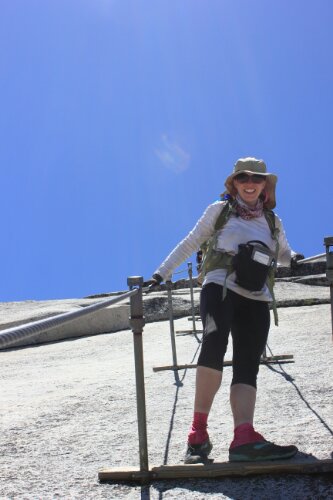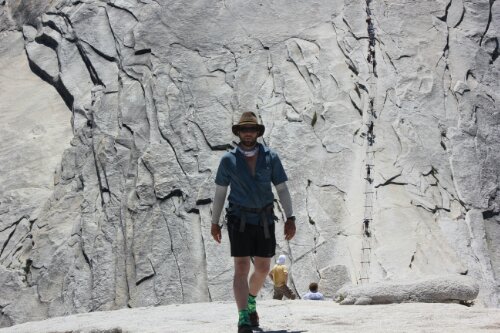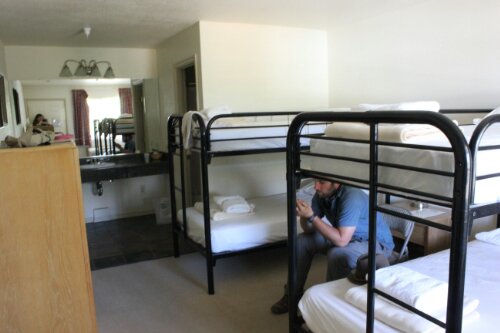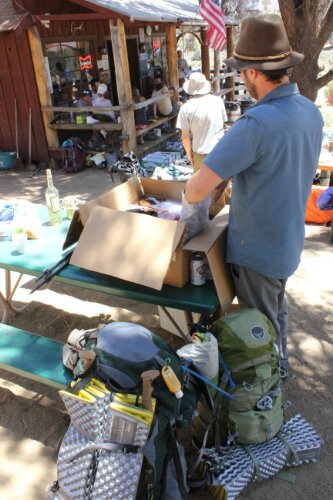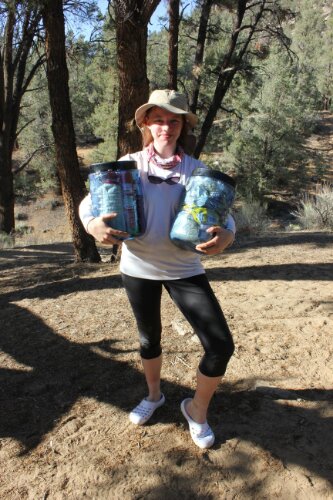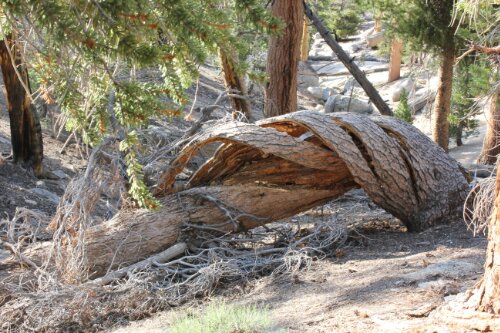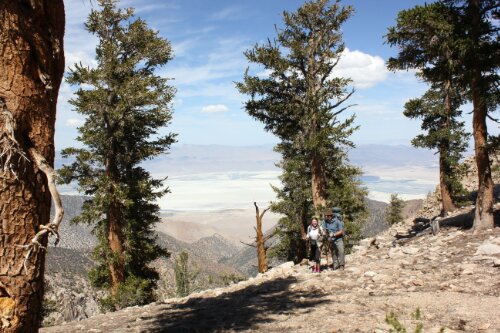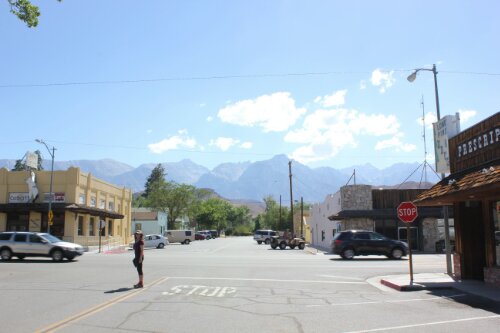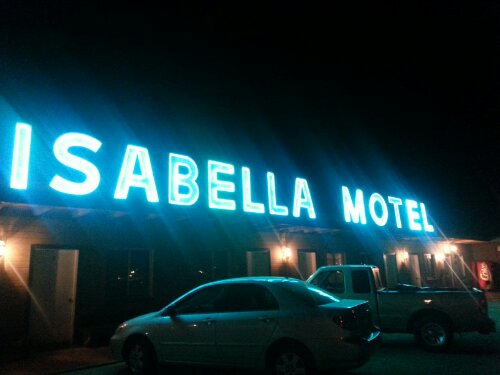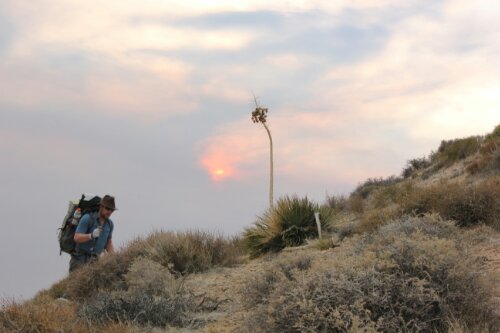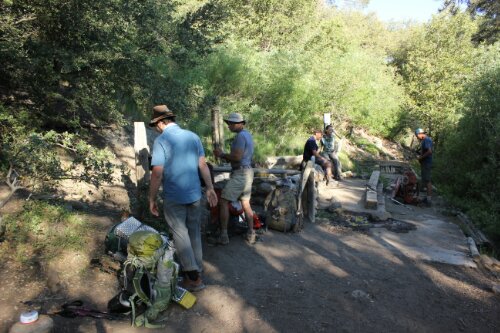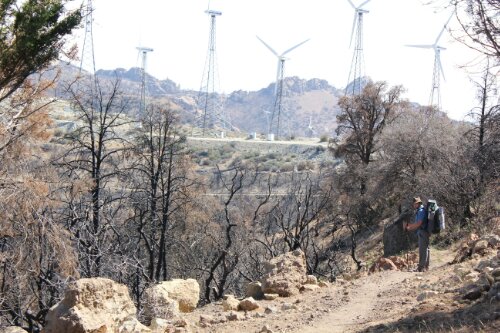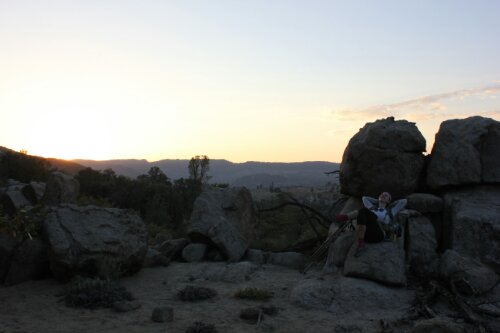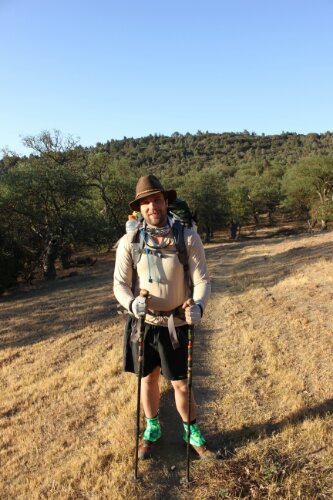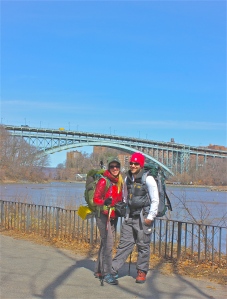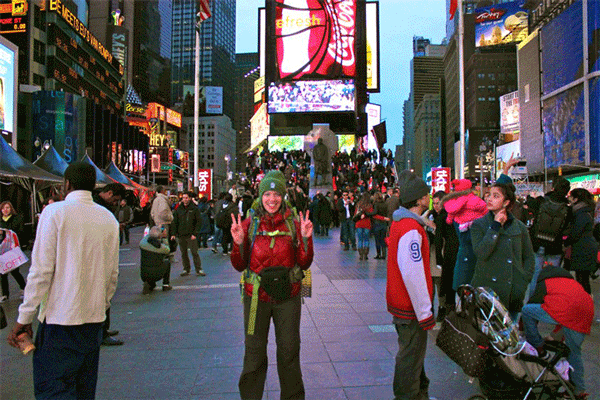Tuolumne Meadows is a lot of fun; compact, full service, and near a nice campground. There is a great little Store at which to resupply, and the staff at the Post Office are really cool and friendly.

We stayed one night at the Tuolumne Meadows campground, and ate at the grill, which is attached to the General Store/PO. Surprisingly good food — fresh veggie chili, home cut fries. In the morning, we ate there one last time before we set out on the Trail. Buckwheat pancakes sent us off into the mountains and meadows for the next 8 days.
The hike out was immediately beautiful and pleasant, like scenery from a fairy tale. Rivers flowing over granite rock. Meadows, forrests, WATERFALLS!!


We spent our first night just 6 miles in at a campground called Glen Aulin. There were several other hikers camped there who were doing an overnight trip, or other trails in Yosemite. But you could spot the PCT hikers: they were the ones who arrived at 8:30pm and were long gone by 6am. We still don’t quite fit the thru-hiker criteria.
We had our first official river-crossing across a log. Remember when we practiced balancing on a log in Central Park? That practice would sure come in handy over the next week. Here’s a little montage of some of the river crossings we did over the next 8 days:












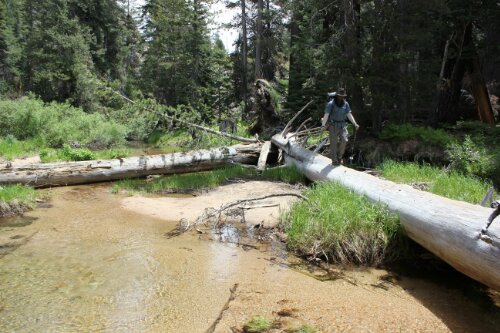
On our second night, we built a little campfire as the sun set. We were camped next to a giant white granite wall that seemed to glow even after the sun had set, though there was no moon in the sky.

By the time we put out the fire, it was pitch black except for the granite wall, which was glowing so brightly, it was practically florescent. The source of the glow was puzzling, until we wandered to the far edge of our camp area and were almost blinded by the rising of the brightest full moon either of us had ever seen. Like a spotlight, it was too intense to look directly at, and it cast shadows behind us as if it were the sun.
No wildlife in this section yet, except for the Sierra mosquitos that we’d heard so much about. Strangely, the mosquitoes were non-existant in Yosemite Valley, but they made their presense known up in the high country.
We climbed higher and higher over the next two days, averaging about 11 miles a day. We are really glad to have decided to slow our pace, mainly because our bodies can barely go any further than those 11 miles by the end of the day.

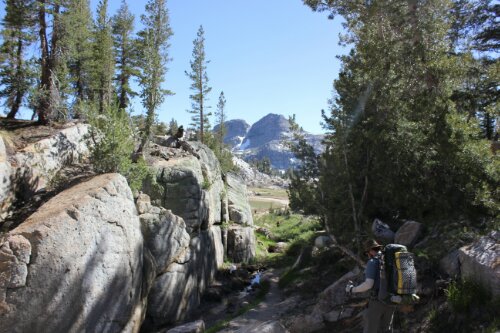
The mountain climbs, and especially the descents, wreak havok on the knees and foot bones. But, we’re also glad to have a slower pace because it allows us to take in the amazing scenery. We wish that we could have stayed at these gorgeous alpine lakes all day.


It was at these lakes that we had our first wildlife encounter of this section of the trail: giant, waddling marmots! They apparently liked the alpine lakes as much as we did. We couldn’t belive how fat and cuddly they looked, even larger than our cat at home! Unfortunately the marmots waddled too quickly into hiding before we could capture a picture of them, so here is a picture of our cat instead:
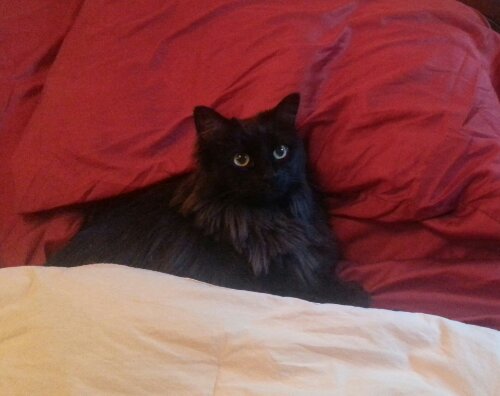
We miss her a bunch, and wish we could have taken her on the trail with us, but recent experiences prove that she would not enjoy it very much.
Every time the fifth day on the trail rolls around, we hit a block of some sort, either mental or physical. In the desert section, it was on the fifth day that we decided not to hike straight through to Kennedy Meadows, but rather to make a pit stop in Lake Isabella. Before Mt. Whitney, it was on the fifth day that we decided to take the “out” down to Lone Pine. This time, on our fifth day, we awoke to find ourselves floating on a water bed. The water had luckily not seeped in to our tent, but about 4 inches of water had pooled above our ground tarp, under our tent, giving our sleeping pads the sensation that they were floating. It was our first rain of the trip — our first truly overcast day! — and it was cold, and coming down hard. Fog was everywhere and we couldn’t see the tops of the mountains that were next to us. We made the decision to take a “zero” day on the trail, and we stayed put in the shelter of our tent…after moving it up to a slight hill, so that we weren’t camped in a swimming pool. We spent the day reading a Dean Koontz novel and playing solitaire as the rain poured down. It was nice.


The next day, it was still rainy and misty, but we needed to hike on. We had camped on an island between two rivers; it was a nice little spot with a fire ring in place from previous hikers. Before the rain had come two days earlier, it was simple to access the island from the trail by hopping across a string of conveniently placed rocks. But now, after more than 24 hours of solid downpour, those rocks were 2 feet underwater!
We scoured the island up and down, crawling through bushes and willows. We eventually found a fallen log to cross, and we made it back to the trail safely. We discovered that much of the trail itself had turned into a river, and in places where the trail inclined or declined, the trail had turned into a waterfall! Needless to say, we were hiking with wet feet, but our Keen socks happily kept our feet warm.



A few wet miles later, we came across a major river…with no log to cross on. Up until this point, all of our river crossings had been made above the water on a log or rocks. This time, the swollen river rushed swiftly, but there was nowhere to cross without getting in. Our guidebook mentioned that there was a log 50 to 100 yards upstream, so we climbed along the river bank for almost a mile, but there was no longer a log. We circled back on the trail and once again came to the point where it intersected the river, after a 2 mile detour. We decided to check downstream to see if there was anything that could help us across. A short distance down, there was a fallen tree stretching all the way across! Hurray!

Paul went first, and as he neared the end of the tree, he paused as vertigo overtook him. He slipped at the last possible second, but by that point, he’d made it far enough over that he was able to catch himself on the shore without landing in the river. Katherine watched, and didn’t know that he’d experienced vertigo. In fact, it didn’t look like he slipped, but rather that he purposefully hopped off the log onto the shore. She started across the tree just fine, since the tree was wider at the beginning. But halfway through the journey, the tree trunk narrowed to about 8 inches, and all she could see was white crashing water rushing beneath her feet. The vertigo! She almost lost her balance right in the middle of the river, but she reached out and grabbed a tree branch that was poking out of the trunk. As she reached for the branch, her trekking pole, which had been wound around her wrist, unwound, slipped off her hand and disappeared into the current. At this point, she began screaming bloody murder (hey, she’s not called Meltdown for nothing!), and stood clutching the branch for a good 3 minutes trying to regain her balance. Everytime she looked down, all she could see was the crashing water. Finally, she calmed and centered. Paul had gotten back up on the tree trunk ready to do whatever it took to get her across. Finally she took two more steps towards him and held out her remaining pole which Paul grabbed and pulled her to safety. Whew! Adrenaline. It was scary, and we were both giddy with relief afterwards.
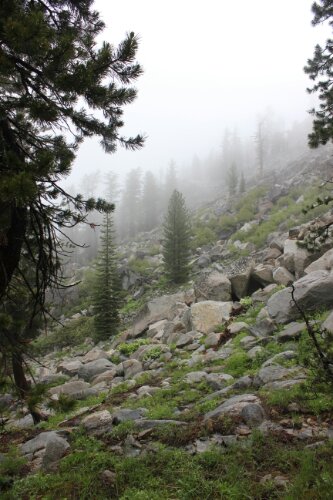
A few miles later, after climbing and descending another mountain through the rain and fog, and lamenting the lost trekking pole, we came across another river, this one even angrier than the first. We once again walked along the riverbank for a while looking for the best place to cross. This time, we found a nice wide log with lots of traction.

We made sure our electronics were secured in our waterproof Aloksaks and Zpack bags, and then made our way across the log. This time, Katherine went first, and though the bungee cord on her gater got caught on a tiny branch, she successsfully backed up without a problem, unlatched the bungee and carried on. Once again, we were flushed with relief and adrenaline to have crossed such an intense river safely, and were pretty sure that was the last major river crossing of the day. We hiked back down to where the trail met up, only to discover the awful truth….we were on another island! We had to cross yet another river to get to the the trail! This final river was not crashing white water, but was wide, deep, and swift moving. We couldn’t be sure how strong the current was, but after checking the perimeter of the entire island, it became clear: we were going to have to swim.
In prepping for the trip, we had watched many videos of PCT hikers swimming across rivers with their packs, but it was always on hot, sunny days, when anyone would want to jump in to a beautiful crystal river and cool off. But on this day, it was so cold that we could see our breath, we hadn’t seen the sun in almost 3 days, and the idea of submerging into ice cold water seemed insane. But it was our only option, unless we wanted to head back to Tuolumne Meadows, 40 miles away. We stripped off our thermal clothing and underwear, and secured it in a Zpack. We wore only our rain pants, rain jacket, shoes, and (already drenched) socks. We took our packs off. When crossing in water, it is best not to wear your pack, or at least not have it buckled to you. That way, if the current is really strong, you won’t get pinned down by your pack.
We didn’t know this ahead of time, but we made the happy and wonderful discovery that our packs actually floated! They were covered in their yellow rain covers, and we placed the packs in the river with the rain cover in the water. It made a little backpack boat…awesome! Katherine went for it first, pushing her backpack boat ahead of her. The current was strong but not too bad. The icy water climbed up the legs past the waist, up to the chest. She walked on, gasping from the cold. But halfway across, she realized she could still touch the bottom of the river and was able to continue to walk. She yelled out to Paul behind her, “Hey, This isn’t so bad!” and made her way to the shore. Once she got out, she watched Paul cross the river with his backpack boat, who looked like a determined sea otter.
We were both totally gleeful and delirious with joy once we made it across…our first true river crossing with packs! It felt like the energy of the trip suddenly changed from hardship and trials to fun and adventure. And then, as if some sort of magical sign from the heavens: just as Paul got out of the river and we set our packs on some tree stumps, the sun burst out through the clouds and shone right on the spot where we were standing, dripping wet and shivering. Literally the first sunshine that we’d seen in days! It only lasted about 45 seconds before it vanished again in the veil of clouds, but we took it as a very good sign.
We got back on the trail, and made our way up the mountain a little ways until we found a nice flat spot to change out of our rain gear and back in to dry clothes. We made some warm tortilla soup as well. While we ate, we began to talk about that feeling of isolation on the trail, and how we hadn’t seen anyone else for a couple of days…were we the only ones out in the mountains fording the rivers, and hiking in the rain? Were we all alone out here in the middle of nowhere? In those videos of PCT hikers fording rivers in the sunshine, there was always a group of them doing it together, but we had been by ourselves…The whole time we’d been unsure: was there actually a bridge downstream that we’d missed that all the other hikers knew about?
Suddenly another hiker appeared, just as we were having this discussion. He had taken a zero during the rain as well, listening to audio books on his ipod in the shelter of his tent. He had crossed the same skinny tree that we had on the first river, and claimed that he’d almost lost his life on it. In fact, he said that the tree had actually cracked when he was three quarters of the way across. How scary would that have been?! And get this: he lost his trekking pole on that same river. There must be a beaver downstream of that skinny tree with a dam made of trekking poles. This hiker crossed the second angry river on the same big log that we did, AND was met with the same slap-in-the-face realization that he was on an island and had to cross yet another river.
So we weren’t alone after all. This hiker had been experiencing everything we had been, just a half-hour behind us, and he had done it all by himself! We hiked with him on and off for the rest of the day, and even encountered one last wide-but-shallow river to cross before we set up camp that evening.

We also came across another hiker, a young guy, who asked for a hug because he’d had a terrible time crossing those rivers: in the river, he lost his ipod, Chrome Dome umbrella…and his camera!


It remained cloudy for the rest of the day, but began to break up by sunset. That night, the sky was completely clear and full of stars. The next morning was leisurely, as we took time to dry out our tent, socks, and shoes, and solar charge our phones. We didn’t start hiking until 11 am.
And then another breakthrough: our first 18 mile day. Though we got a late start, we realized we’d already gone 8 miles by 1 pm, and we decided to push for the distance.


The terrain was relatively flat and full of mosquitos (trust us, those little buggers propel you to move it along quickly!). Plus, we realized that if we did 18 miles that day, we could make it to town the very next day.
Enchiladas!
Pancakes!
Ricotta-filled ravioli!
Showers!
All this and more could be ours if we made it town.
So we did it. 18 miles. That night, our feet hurt so bad that we couldn’t sleep for a long time.

The next day was an exciting one: our first ridge walk, and town – town – town.

The ridge was beautiful, but harder than we imagined, and we were still recovering from the 18 miler the day before.


It was a steep climb to get up there, and the trail was full of loose rocks and snow fields. We used our crampons for the first time, and they worked great, but it was tricky because the snow fields were interspersed with rock fields, and you can’t wear crampons on rocks. It’s pretty time consuming to keep putting on and taking off crampons so we only used them for one really wide snow field, and didn’t bother using them for the others.


We finally made it to highway 108 at Sonora Pass around 4 pm. Turns out, a group of Trail Angels were doing Trail Magic there, and we immediately got served some sodas and hot dogs. We secretly hoped they would give us a ride to town, but didn’t want to flat-out ask them. None of them offered, so after we thanked them for the snack, we headed out to the highway to hitch for a ride. After an hour and half, we still were waiting for someone to stop. True, there wasn’t a ton of traffic, but we thought that surely someone would stop. No one did, and it was getting late. We headed back up to the Trail Magic just as they were serving a pasta dinner. We were very grateful for it, and decided to camp there for the evening and try for a hitch again in the morning.

Though we didn’t get in to town that night, we were treated to a beautiful lightning storm and cloud show in the distance (it didn’t reach us), and we were happy.

The next morning at 8 am, we were back on the highway again. A few cars passed without stopping, and Katherine almost melted down, thinking we’d never get in to town. The pancakes, the enchiladas, would never be had. We would starve on the side of the highway…dirty, sunburnt, and smelly.
But then an Angel arrived in a shiny red truck. His name was Paul (already a good sign!), and he was headed right through the town that we wanted: Bridgeport. Just when we had thought all hope was lost, he saved the day. He kindly drove us the entire 30 miles, even took us on a field trip to visit the nearby hot springs, and dropped us off right in front of a quaint little motel in the darling cowboy town of Bridgeport. Thank you Paul!!

Bridgeport has been a wonderful town stop. Friendly people, good food, nice library and motel. We’ve been very happy to clean up here and rest up. Our plan is to hitch back to the trail tomorrow and hike in to Lake Tahoe in about 8 days.
Some folks have asked about sending mail to us along the trail. We love getting mail, especially if it’s edible! Thank goodness our appetites have returned in the alpine climate after having been absent in the hot desert. We love getting letters and postcards, too! The “contact us” page above has the addresses that we will be picking up resupply packages. To mail to us in Lake Tahoe, you can send to:
Katherine Wroble and Paul Barney
General Delivery
South Lake Tahoe, CA 96151



